Overview
This article delves into the transformative role of augmented reality (AR) software in enhancing e-commerce engagement through innovative strategies. Research indicates that AR significantly improves customer interactions, boosts sales conversion rates, reduces return rates, and fosters brand loyalty. By providing immersive and personalized shopping experiences, AR not only meets consumer expectations but exceeds them, as demonstrated by successful case studies from industry leaders such as L'Oréal and IKEA. These proven strategies highlight the necessity for e-commerce brands to adopt AR technology, ensuring they remain competitive in an increasingly digital marketplace.
Introduction
Augmented reality (AR) is revolutionizing the e-commerce landscape, fundamentally transforming how consumers engage with brands and products. As businesses increasingly adopt AR technology, they unlock significant opportunities to enhance customer engagement, boost sales, and reduce return rates. However, the pressing question remains: how can brands effectively integrate AR into their marketing strategies to not only attract but also retain a loyal customer base in an ever-evolving digital marketplace? This article explores seven impactful ways AR software is reshaping e-commerce engagement, providing critical insights into how companies can leverage this innovative technology to maintain a competitive edge.
Magic Playbox: Transform Customer Engagement with Immersive AR Solutions
Magic Playbox stands at the forefront of crafting immersive experiences using augmented reality software that significantly transform user engagement. By harnessing advanced technology, the studio develops solutions that not only elevate marketing strategies but also foster unforgettable interactions for users. Their innovative projects have led to remarkable improvements in client engagement metrics, underscoring the substantial impact of AR in e-commerce environments.
Research indicates that companies employing AR features have reported sales growth of up to 80%. For instance, L'Oréal's virtual makeup try-ons illustrate how AR can boost consumer confidence and result in higher conversion rates. Successful campaigns, such as Gucci's AR sneaker try-on, which reached over 18 million unique users, exemplify the effectiveness of AR in connecting with digital-savvy audiences.
The pandemic has accelerated the transition to digital options, encouraging companies to increasingly embrace augmented reality software as a crucial component of their marketing strategies. As the landscape of e-commerce evolves, the incorporation of augmented reality software continues to redefine how companies interact with their clientele, making it an essential component of contemporary marketing strategies.
Furthermore, measuring AR ROI is crucial for brands to understand the full impact of their AR initiatives. AR interactions provide valuable consumer data that can enhance personalized marketing efforts, ultimately driving success in an increasingly competitive market.
Enhanced Product Visualization: Boost Sales with AR Technology
Augmented reality software empowers users to visualize products within their own environments, thereby significantly enhancing the shopping experience. Research indicates that products featuring AR content achieve an impressive average of 94% higher conversion rates compared to those lacking such features. This capability not only drives sales but also reduces return rates, as augmented reality software enables buyers to virtually experience products prior to purchase.
For example, companies like Warby Parker have effectively leveraged AR for virtual try-ons, resulting in increased customer satisfaction and heightened purchase intent. Furthermore, AR has been shown to elevate online shopping sales by up to 200% through effective product visualization. This makes augmented reality software an essential tool for e-commerce businesses aiming to enhance their bottom line.
Additionally, companies such as IKEA have adopted augmented reality software, which has led to greater customer satisfaction and increased sales, underscoring the broader impact of augmented reality software in fostering stronger customer relationships and encouraging repeat purchases.
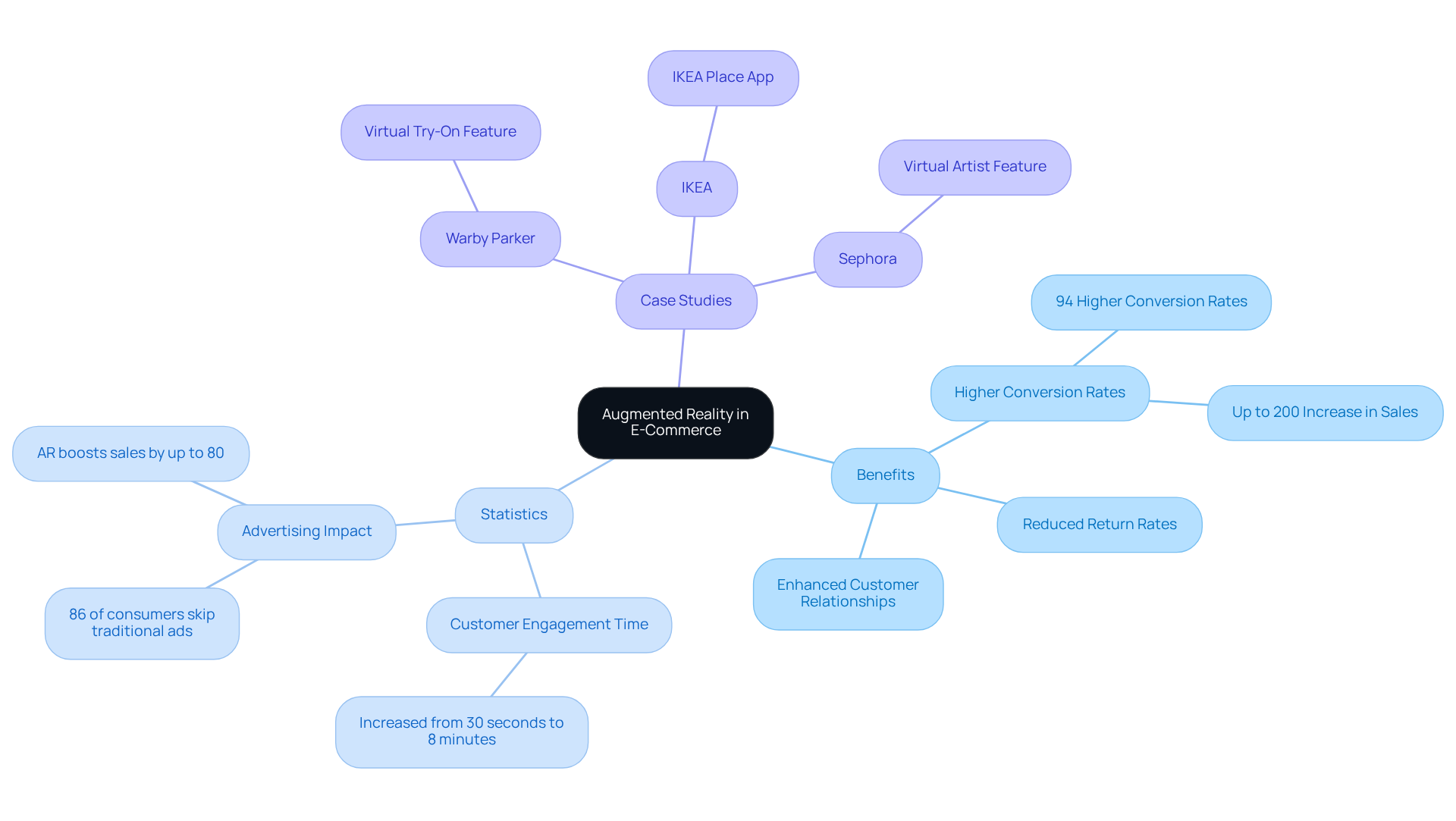
Interactive Shopping Experiences: Engage Customers with AR
Augmented reality (AR) transforms shopping into an engaging interaction that captivates shoppers and encourages exploration. Virtual try-on features exemplify this innovation, enabling users to upload a photo and visualize how clothing or accessories will appear on them prior to making a purchase. This level of interactivity not only enhances user engagement but also fosters a deeper emotional connection with the brand, resulting in increased loyalty and repeat purchases.
Research indicates that such engaging activities can significantly boost client loyalty and repeat purchases, with AR interactions leading to sales increases of up to 80%, according to Magic Playbox. Retail specialists, including Dani Nadel, assert that "this year, commerce isn’t solely focused on transactions—it’s about narratives, encounters and connections that are personal and unforgettable."
As online retail continues to evolve, integrating AR technology will be crucial for brands aiming to enhance customer experiences and cultivate loyalty. Furthermore, the augmented reality market is projected to reach US$ 635.67 billion by 2033, underscoring the growing significance of AR in the online shopping landscape.
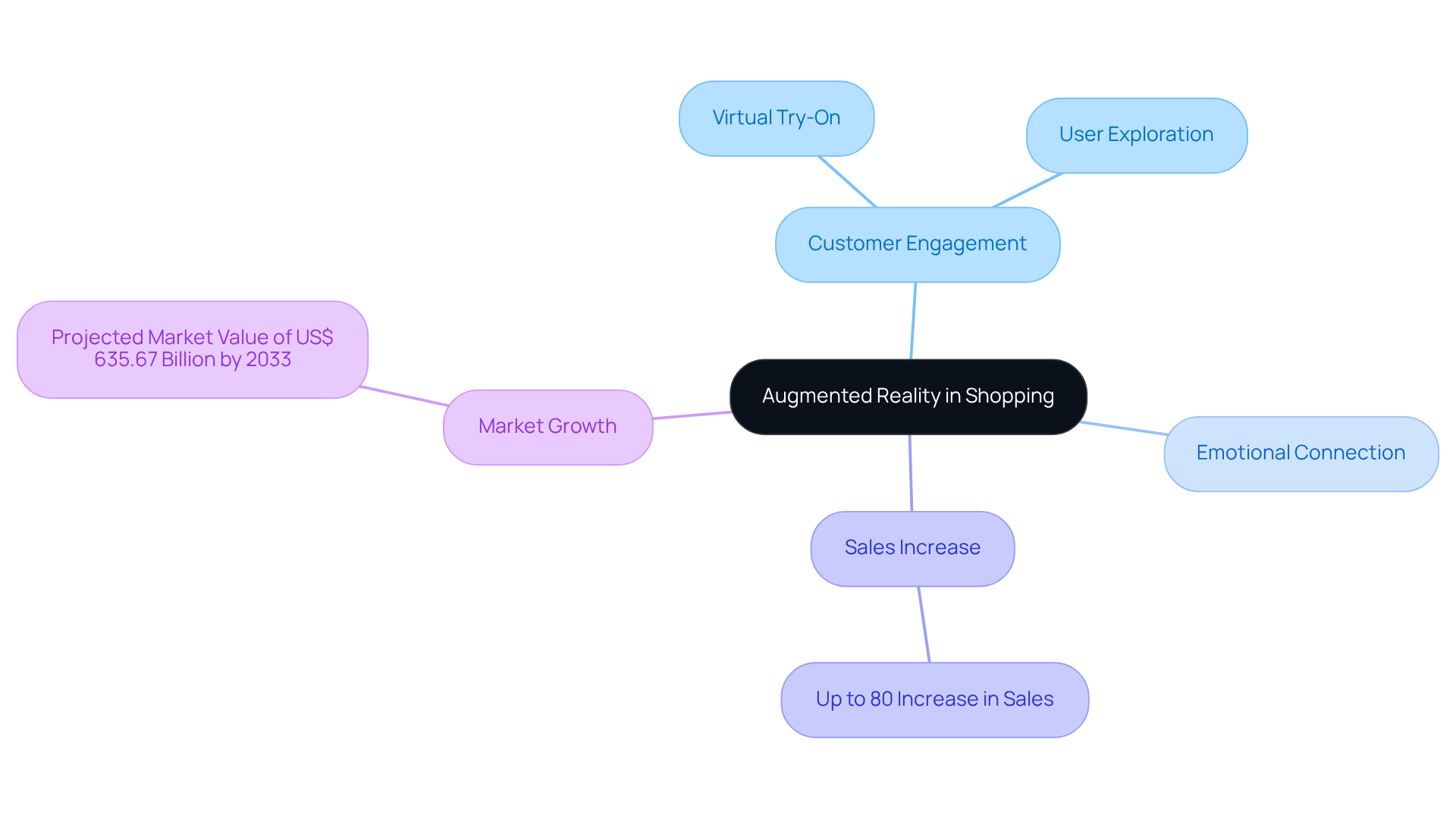
Reduced Return Rates: Improve Purchase Confidence with AR
A key advantage of augmented reality (AR) in e-commerce is its remarkable ability to lower return rates. By enabling users to visualize products in their own environments, AR empowers them to make more informed purchasing decisions. Research indicates that AR can decrease return rates by up to 40%, directly associated with AR technology, as individuals gain assurance in their decisions when they can observe how products fit into their lives.
For instance, Build.com has reported that shoppers using AR features return 22% fewer items compared to those who do not, a statistic derived from their findings. This trend is echoed by SeekXR, which found a 25% decrease in returns for AR-assisted purchases based on their collaboration with large-scale e-tailers. Furthermore, a significant 80% of consumers feel more confident in their purchases when utilizing AR tools, according to a survey by Alter Agents.
As retailers progressively embrace augmented reality software, the impact on client satisfaction and loyalty becomes clear. Notably, retailers utilizing augmented reality software see a 94% rise in conversion rates, establishing augmented reality software as a vital element of contemporary e-commerce strategies.
Magic Playbox leads this transformation by offering innovative augmented reality software solutions that boost user engagement and foster loyalty.
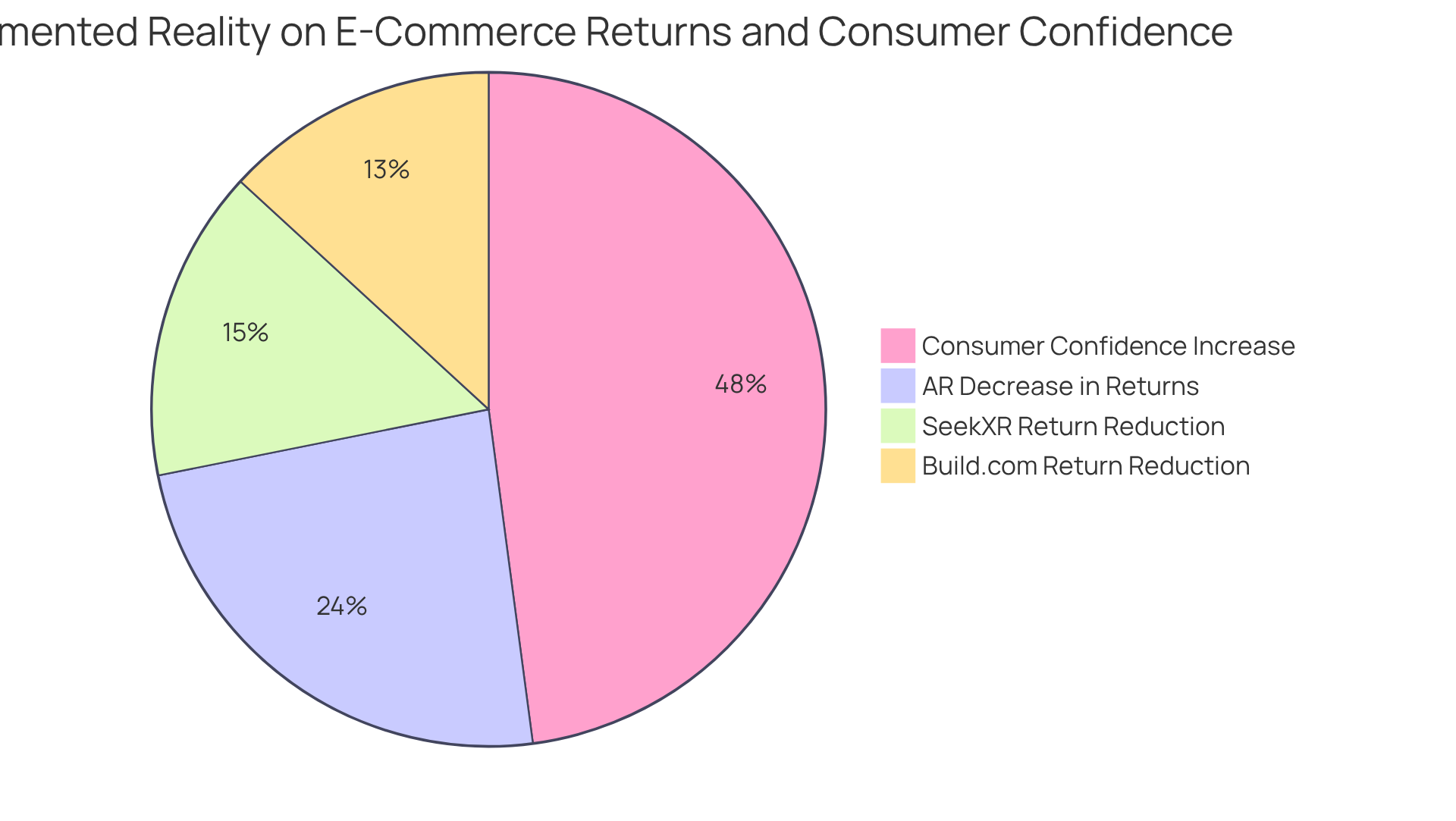
Personalized Shopping: Foster Customer Loyalty through AR
Augmented reality software empowers brands to craft highly personalized shopping interactions that resonate with individual preferences. By leveraging data analytics, companies can customize AR experiences to highlight products aligned with a consumer's past purchases or browsing behavior. This targeted approach not only enriches the shopping journey but also cultivates loyalty, as consumers appreciate being recognized and understood.
Research indicates that over 70% of buyers prioritize the shopping experience over merely acquiring products, with 80% more likely to purchase after engaging in such personalized interactions. Brands that adeptly harness data analytics within their augmented reality software strategies can significantly boost customer satisfaction and retention, ultimately propelling sales growth.
For instance, Gunner Kennels experienced a remarkable 40% increase in order conversion following the integration of AR tools, underscoring the tangible benefits of personalized AR interactions. Furthermore, the market for augmented reality software in retail is projected to expand from $19.9 billion in 2024 to $64.6 billion by 2030, emphasizing the critical need for brands to adopt AR strategies in e-commerce.
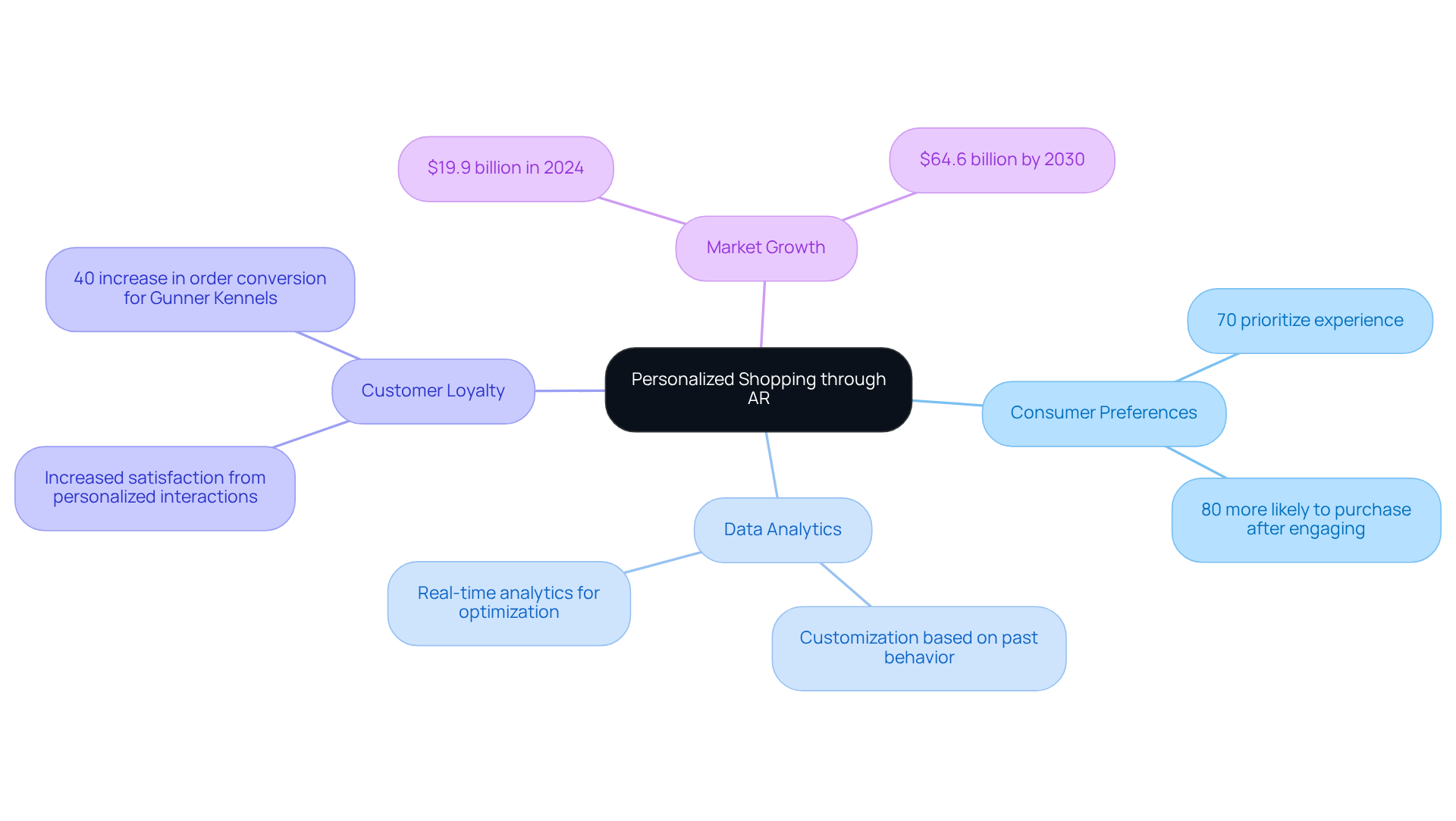
Social Sharing: Amplify Brand Visibility with AR Experiences
Augmented reality software interactions are inherently designed for sharing, enabling users to showcase their engagements with products across social media platforms. This dynamic not only amplifies visibility but also fosters user-generated content (UGC), which acts as authentic endorsements for the company.
For instance, brands like GoPro have successfully inspired customers to share their narratives through the GoPro Award initiative, which has proven effective in enhancing engagement and loyalty by spotlighting genuine user footage.
By crafting compelling interactions using augmented reality software, companies can harness the viral potential of social media, thereby reaching broader audiences and refining their marketing strategies.
As social media algorithms, such as Instagram's, increasingly favor authentic interactions over polished advertisements, the integration of UGC through AR emerges as a strategic choice to cultivate engaging and genuine brand experiences. This approach not only enriches user experience but also propels higher conversion rates by bolstering consumer confidence, as individuals are more inclined to trust real user experiences when making purchasing decisions.
UGC types that can be seamlessly incorporated into augmented reality software campaigns include:
- AR filters
- Virtual try-ons
- Product demonstrations
These elements further enrich the engagement landscape.
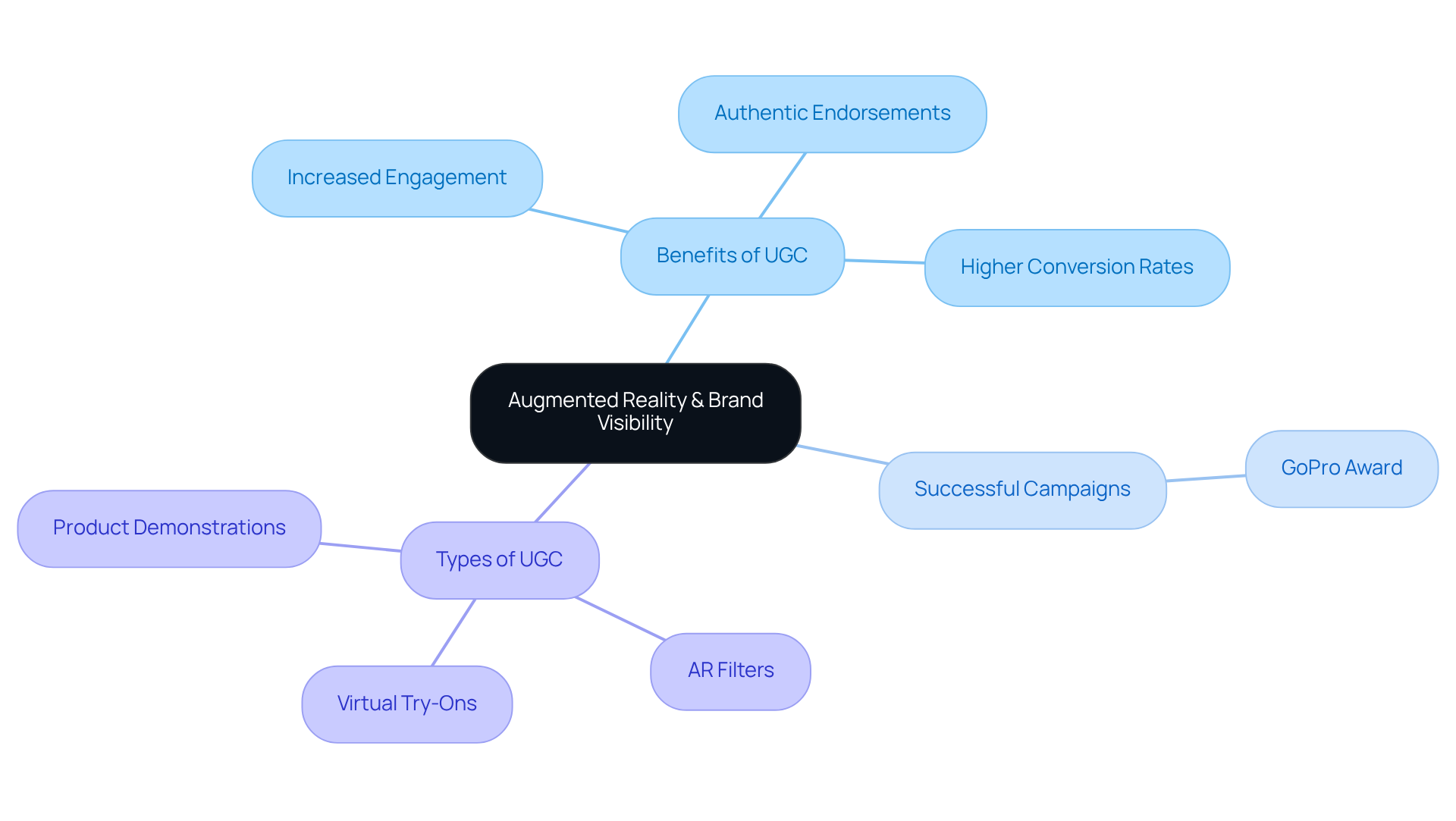
Seamless Integration: Enhance User Experience with AR in E-commerce
To maximize the effectiveness of augmented reality software in e-commerce, seamless integration into existing platforms is crucial. This integration ensures that AR features are easily accessible and intuitive, requiring minimal technical knowledge from users. By concentrating on user interaction during the integration process, brands can significantly improve client satisfaction.
Research indicates that when AR is user-friendly, it not only encourages more frequent use but also drives sales and engagement. Retailers such as IKEA exemplify this approach, effectively employing AR applications that enable individuals to visualize how furniture fits in their homes, thereby enhancing the overall shopping journey.
Additionally, features like virtual try-ons in fashion have proven to increase conversion rates and reduce return rates, showcasing the power of user-centric AR solutions. Ultimately, prioritizing user experience in AR technology fosters stronger connections with clients, leading to increased loyalty and repeat purchases.
Brands must act now to leverage these insights, ensuring they remain competitive in the evolving e-commerce landscape.
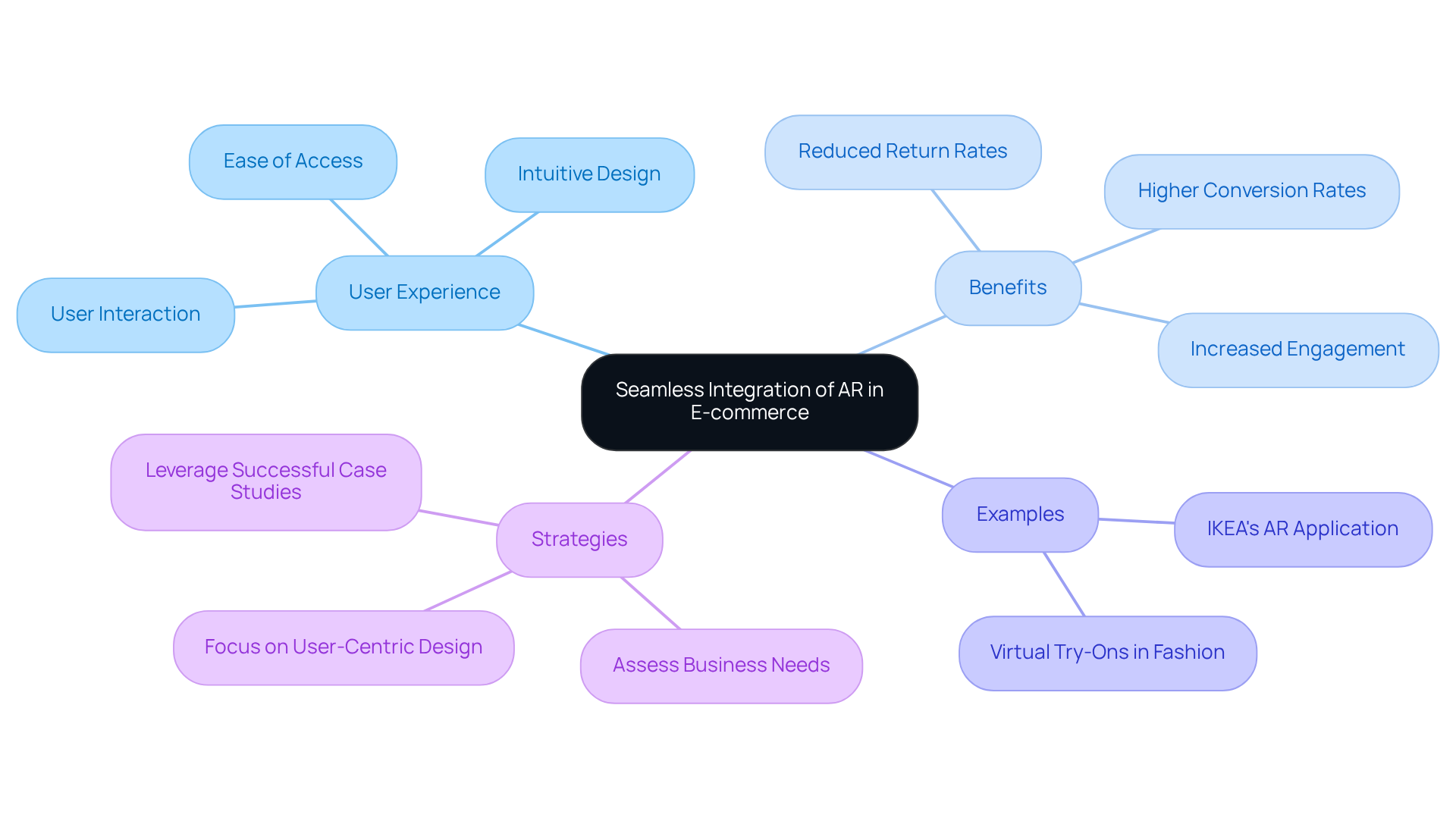
Cost-Effectiveness: Maximize Marketing ROI with AR Solutions
Investing in augmented reality software is a highly cost-effective strategy for e-commerce brands. By significantly enhancing client engagement—shoppers spend 40% more time exploring products with AR—and reducing return rates by 25% to 40%, AR can dramatically improve marketing ROI. Brands that have adopted AR technologies report conversion rates soaring by up to 94%, showcasing the tangible benefits of these investments.
For instance, companies like Makeup by Mario have integrated AR features that allow customers to virtually try on products, leading to increased sales and customer retention. Furthermore, 61% of shoppers express a preference for retailers that offer AR, underscoring the importance of these technologies in modern retail.
As AR technology progresses, implementation expenses are anticipated to decrease, with no-code platforms such as BrandXR enabling small and medium enterprises to launch AR applications at a fraction of previous costs. This evolution positions AR not merely as a luxury but as a necessary component of modern e-commerce strategies, driving both engagement and profitability.
Informed Purchases: Educate Customers with AR Content
Augmented reality software stands as a formidable educational tool, delivering detailed product information in an engaging manner. Magic Playbox's innovative augmented reality software facilitates interactive engagements that effectively demonstrate product features, usage guidelines, and advantages, thereby significantly enhancing buyer understanding of their purchases.
For example, L’Oreal observed a remarkable 40% increase in makeup sales six months following the launch of their Style My Hair AR app, which empowers users to preview hair color shades through live camera views. This case exemplifies how augmented reality software can elucidate product offerings and bolster consumer confidence.
The educational facet of augmented reality software not only enhances the shopping experience but also fosters trust between the company and the consumer, ultimately leading to heightened satisfaction and loyalty. As Akram Atallah, CEO of Identity Digital, aptly stated, "Strategically incorporating AR into your organization's strategy means you can stay ahead of the curve, innovatively engage with clients and create memorable interactions that drive loyalty and growth."
Furthermore, an Accenture survey revealed that over 71% of purchasers indicated they would shop more frequently if augmented reality software were available, underscoring the significant potential of augmented reality software to transform online shopping engagement.
By leveraging augmented reality software from Magic Playbox, online retail managers can enhance customer interaction and drive sales efficiently.
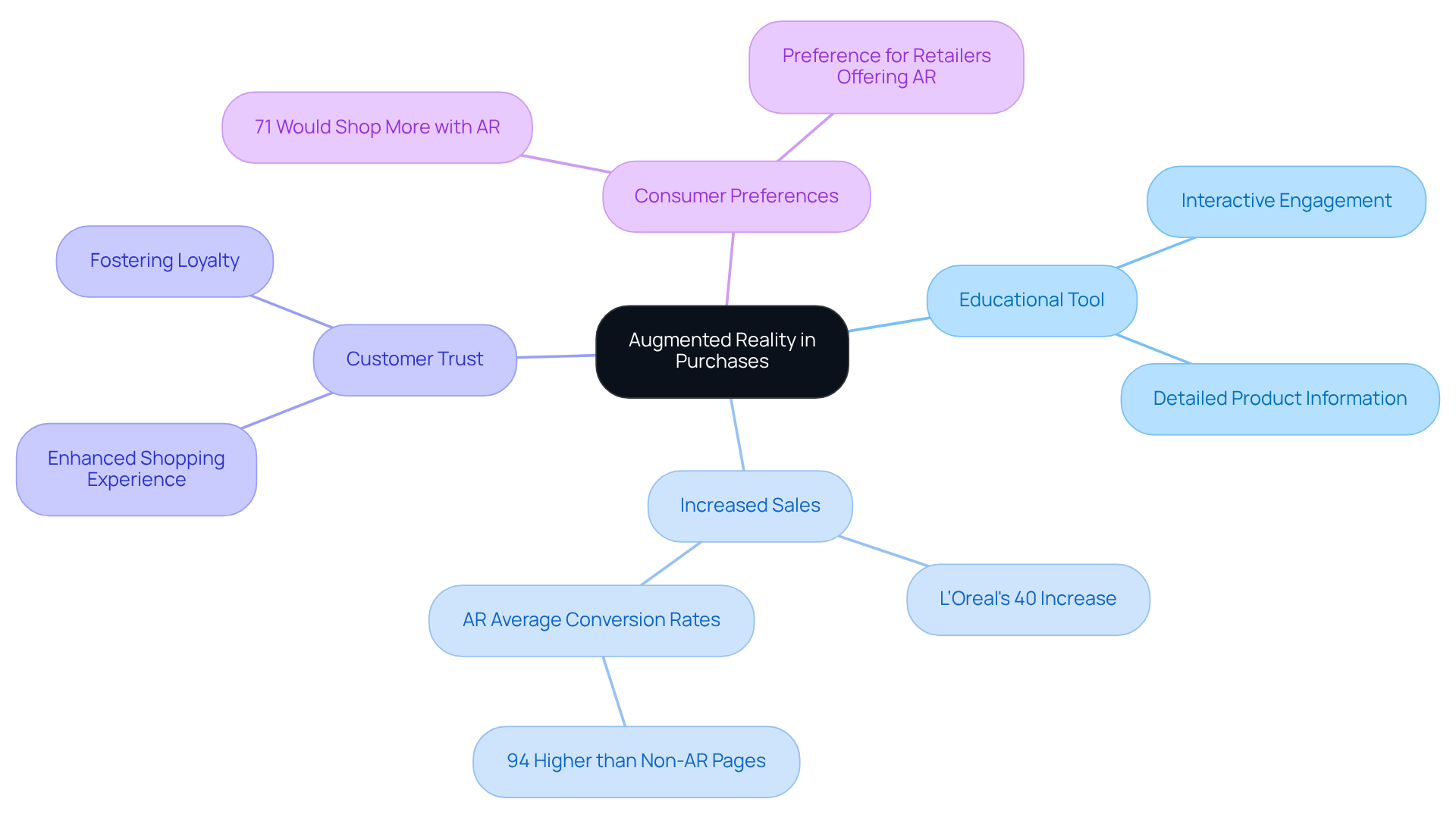
Future-Ready: Stay Competitive with Innovative AR Technologies
In the rapidly evolving e-commerce landscape, brands must leverage innovative augmented reality software technologies to maintain a competitive edge. By adopting the latest augmented reality software trends, businesses can create engaging interactions that not only set them apart from rivals but also attract a tech-savvy consumer base. Research indicates that 61% of consumers prefer shopping at retailers that offer augmented reality software experiences, highlighting the increasing demand for such interactive shopping solutions. Furthermore, companies that utilize augmented reality software in their strategies can witness conversion rates surge by as much as 94%, significantly enhancing client engagement and satisfaction.
Prominent e-commerce companies are already utilizing augmented reality software to elevate user interactions. For instance, ASOS utilizes augmented reality software to allow shoppers to virtually try on clothing, thereby enhancing the shopping experience and reducing return rates. Similarly, IKEA's Place app employs augmented reality software to enable users to visualize furniture in their own spaces, effectively bridging the gap between online and physical retail.
Investing in augmented reality software not only prepares companies for future challenges but also positions them as leaders in customer engagement. With the augmented reality software market projected to exceed $50 billion by 2025, early adoption of this technology can yield a substantial competitive advantage. Industry leaders emphasize that the use of augmented reality software in business strategies is essential for fostering customer loyalty and enhancing the overall shopping experience. By staying ahead of augmented reality software advancements, brands can ensure they meet evolving consumer expectations and drive sustained growth.
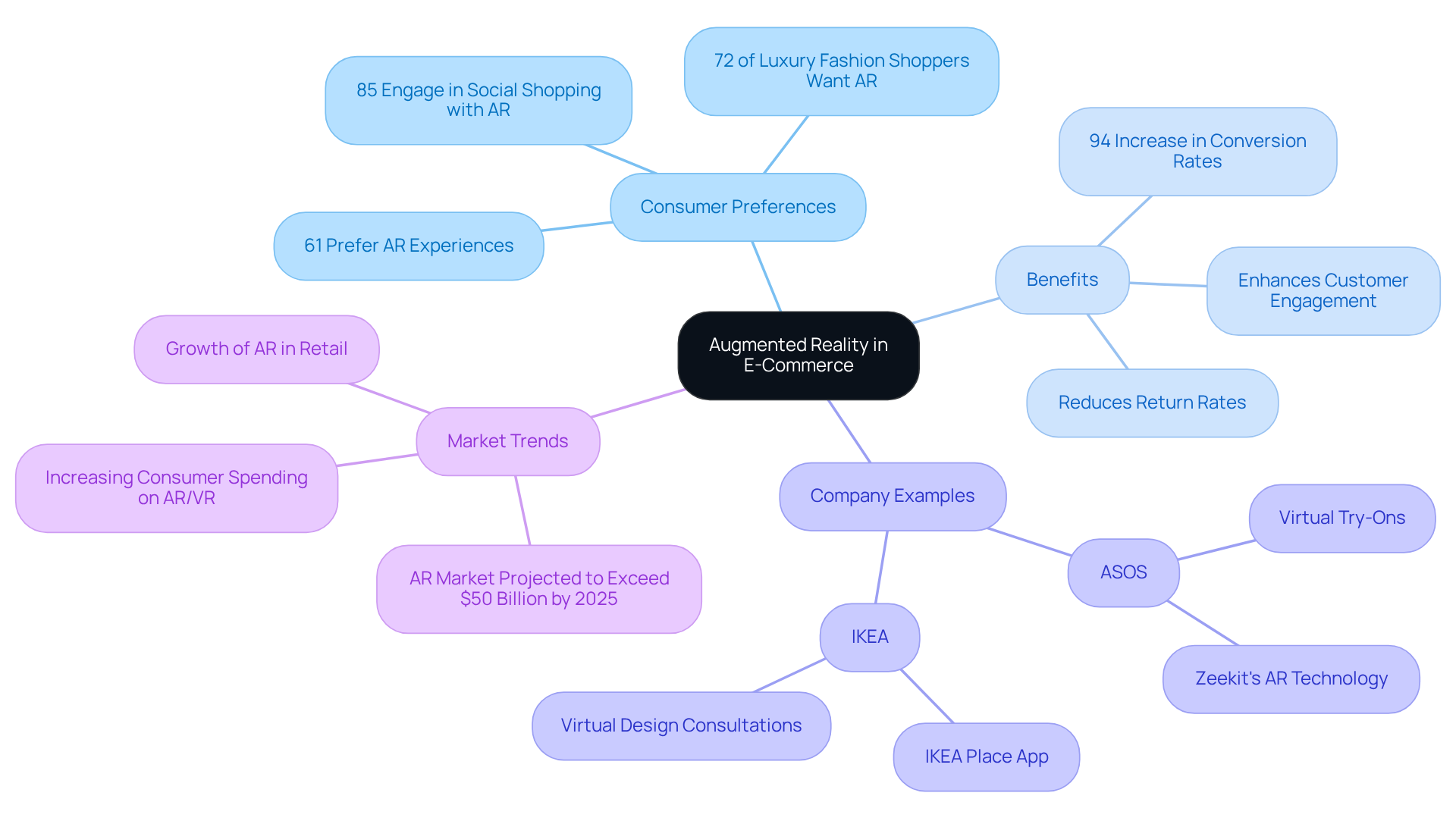
Conclusion
The integration of augmented reality (AR) software into e-commerce signifies a transformative shift in brand-consumer engagement. Leveraging AR technology empowers companies to craft immersive experiences that enhance the shopping journey and significantly boost sales and customer loyalty. The capability to visualize products in real-world settings, combined with interactive features, elevates user engagement and fosters deeper connections between brands and their audiences.
Key insights from the article underscore the impressive benefits of AR, including:
- Increased conversion rates
- Reduced return rates
- Enhanced customer satisfaction
Brands such as L'Oréal and IKEA exemplify successful AR utilization to improve the shopping experience, demonstrating that this technology is not merely a trend but a vital component of modern marketing strategies. Furthermore, the potential for personalized shopping experiences and social sharing amplifies brand visibility, making AR an essential tool for driving customer retention and engagement.
As the e-commerce landscape evolves, embracing augmented reality technology is crucial for brands striving to remain competitive. The projected growth of the AR market highlights the importance of early adoption, positioning businesses as innovators in customer engagement. By investing in AR solutions, companies can meet the demands of a tech-savvy consumer base while creating memorable interactions that drive loyalty and growth. Now is the time for brands to harness the power of augmented reality and redefine the future of online shopping.
Frequently Asked Questions
What is Magic Playbox and what does it specialize in?
Magic Playbox specializes in creating immersive experiences using augmented reality (AR) software, significantly transforming user engagement and enhancing marketing strategies.
How does augmented reality impact customer engagement?
Augmented reality has been shown to improve client engagement metrics, leading to remarkable increases in sales and customer interactions, particularly in e-commerce environments.
What are some examples of successful AR campaigns?
Successful AR campaigns include L'Oréal's virtual makeup try-ons, which boost consumer confidence, and Gucci's AR sneaker try-on, which reached over 18 million unique users.
How has the pandemic influenced the adoption of AR in marketing?
The pandemic has accelerated the transition to digital options, prompting companies to increasingly integrate augmented reality software as a key component of their marketing strategies.
Why is measuring AR ROI important for brands?
Measuring AR ROI helps brands understand the full impact of their AR initiatives, as AR interactions provide valuable consumer data that enhances personalized marketing efforts.
How does augmented reality enhance product visualization?
Augmented reality allows users to visualize products in their own environments, significantly enhancing the shopping experience and achieving higher conversion rates.
What are the conversion rate benefits of using AR in e-commerce?
Products featuring AR content achieve an average of 94% higher conversion rates compared to those without, and AR can elevate online shopping sales by up to 200%.
How have companies like Warby Parker and IKEA utilized AR technology?
Warby Parker has used AR for virtual try-ons, resulting in increased customer satisfaction, while IKEA's adoption of AR has led to greater customer satisfaction and increased sales.
What role does AR play in creating interactive shopping experiences?
AR transforms shopping into engaging interactions, allowing users to virtually try on clothing or accessories, which enhances user engagement and fosters emotional connections with brands.
What is the projected growth of the augmented reality market?
The augmented reality market is projected to reach US$ 635.67 billion by 2033, highlighting its growing significance in the online shopping landscape.




